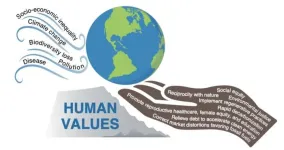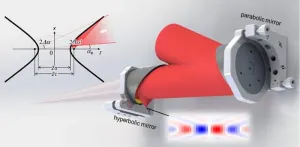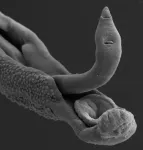(Press-News.org) NEW YORK, NY--Far-UVC light is a promising new technology for reducing airborne virus levels in occupied indoor spaces, but its effectiveness has not been evaluated in real-life scenarios.
A new study by Columbia researchers now shows that far-UVC light inactivated nearly all (>99%) of an airborne virus in an occupied work environment, showing that the technology can work as well in a real-life scenario as in the laboratory.
“The results show that far-UVC is highly effective at reducing airborne pathogens in an ordinary occupied room, and so it’s practical to use far-UVC light in indoor areas where people are going about their business,” says David Brenner, PhD, director of the Center for Radiological Research at Columbia University Vagelos College of Physicians and Surgeons and senior author of the study.
“If this virus had been a disease-causing virus, the far-UVC light would have provided far more protection against airborne-disease transmission than any ventilation system,” says Brenner.
A new air disinfection technology
Conventional germicidal UVC light is a well-known technology for killing viruses and bacteria and is frequently used by hospitals to sterilize rooms. However, direct exposure to conventional germicidal UVC light can potentially harm skin and eyes, so it can only be turned on when a room is empty.
“You can decontaminate a room in the morning before people arrive, but it can quickly become contaminated again because people in the room are shedding viruses and other airborne pathogens,” Brenner says. “The goal is to be able to continuously decontaminate a room while people are in it.”
Over the past few years, Brenner’s team has been developing far-UVC light, which has a shorter wavelength (222-nm) than conventional germicidal UVC light and cannot penetrate or damage living skin or eyes. Laboratory tests at Columbia and other centers have demonstrated that far-UVC quickly and efficiently inactivates airborne pathogens in both small and room-sized test chambers.
A real-world test
In the new study, the researchers wanted to look at the impact of far-UVC light in a room where both people and high levels of virus in the air are present. For ethical and safety reasons, the virus had to be harmless to humans.
At Columbia, a room where laboratory mouse cages are cleaned provided an ideal test setting. Most mice carry a form of norovirus that doesn’t make the animals—or humans—sick, but high concentrations of the virus become airborne when the cages are cleaned.
The researchers installed four overhead far-UVC lamps in the cage cleaning room and collected daily air samples to compare infectious virus levels on days when the lamps were turned on and days when the lamps were turned off. (The lamps were in compliance with current regulatory guidance on far-UVC exposure limits.)
Efficacy surpassed expectations
"Based on our initial sensitivity tests, we expected to see a reduction in airborne virus of around 66%,” says Brenner. The result—a reduction in infectious airborne viruses of 99.8%—surpassed expectations and was far greater than what could be achieved by typical air filtration and ventilation.
The study did not find any measurable difference in air quality (ozone or particulates) associated with far-UVC illumination.
Next steps
Far-UVC lamps are being installed in more public locations, with corresponding measurements of the reduction in airborne pathogens.
Brenner’s team is also performing laboratory studies to directly quantify the effect of far-UVC light on airborne disease transmission.
More information
The study, titled “222-nm far-UVC light markedly reduces the level of infectious airborne virus in an occupied room,” was published March 20 in Scientific Reports.
Other authors (all from Columbia): Manuela Buonnano, Norman Kleiman, David Welch, Raabia Hashmi, and Igor Shuryak.
###
Columbia University Irving Medical Center (CUIMC) is a clinical, research, and educational campus located in New York City. Founded in 1928, CUIMC was one of the first academic medical centers established in the United States of America. CUIMC is home to four professional colleges and schools that provide global leadership in scientific research, health and medical education, and patient care including the Vagelos College of Physicians and Surgeons, the Mailman School of Public Health, the College of Dental Medicine, the School of Nursing. For more information, please visit cuimc.columbia.edu.
END
Far-UVC light can virtually eliminate airborne virus in an occupied room
2024-04-02
ELSE PRESS RELEASES FROM THIS DATE:
A new estimate of U.S. soil organic carbon to improve Earth system models
2024-04-02
Soil contains about twice as much carbon as the atmosphere and plants combined. It is a major carbon sink, capable of absorbing more carbon dioxide from the atmosphere than it releases. Management of soil carbon is key in efforts to mitigate climate change, in addition to being vital to soil health and agricultural productivity.
Measuring soil carbon, however, is a painstaking, expensive process. Samples must be dug from the ground and sent to a lab for analysis, making upscaling measurements on a large spatial scale ...
Scientists’ urgent call: end destruction and forge a just, sustainable future
2024-04-02
An international team of scientists published a study today in the Proceedings of the National Academy of Sciences NEXUS emphasizing the urgent need to align political will, economic resources, and societal values to ensure a more sustainable and equitable world. Led by University of Hawai‘i at Mānoa researchers, the 18 authors combine their expertise in earth and ocean sciences, politics, law, public health, renewable energy, geography, communications, and ethnic studies to assess causes, impacts, and solutions to a multitude of worldwide crises.
“Climate change, ecological destruction, disease, pollution, and socio-economic inequality ...
First results from BREAD experiment demonstrate a new approach to searching for dark matter
2024-04-02
One of the great mysteries of modern science is dark matter. We know dark matter exists thanks to its effects on other objects in the cosmos, but we have never been able to directly see it. And it’s no minor thing—currently, scientists think it makes up about 85% of all the mass in the universe.
A new experiment by a collaboration led by the University of Chicago and Fermi National Accelerator Laboratory, known as the Broadband Reflector Experiment for Axion Detection or BREAD, has released its first results in the search for dark matter in a ...
Focusing ultra-intense lasers to a single wavelength
2024-04-02
Ultra-intense ultrashort lasers are powerful tools used in various fields like physics, national security, industry, and healthcare. They help researchers delve into strong-field laser physics, laser-driven radiation sources, particle acceleration, and more.
“Peak power” measures the intensity of these lasers, like the Nova laser (Lawrence Livermore National Laboratory, California, USA) with 1.5 petawatts of peak power, the Shanghai Super-intense Ultrafast Laser Facility (SULF, China) with 10 petawatts, or the Extreme Light Infrastructure – Nuclear Physics (ELI-NP, Romania) with a peak ...
Combining food taxes and subsidies can lead to healthier grocery purchases for low-income households
2024-04-02
Chapel Hill, NC, April 2, 2024 — A new study that models the combined effects of a sugar-based tax on beverages and targeted subsidies for minimally processed foods and drinks found that under these policies, low-income consumers would purchase less sugar-sweetened beverages and more fruits, vegetables, and healthier drinks, particularly in households without children.
Researchers at the University of North Carolina at Chapel Hill developed a model to simulate what would happen if national-level taxes on less-healthy, ...
One in five people with cancer participate in medical research studies
2024-04-02
SEATTLE – April 2, 2024 – Researchers from Fred Hutchinson Cancer Center, the American Cancer Society Cancer Action Network and peer institutions released new findings in the Journal of Clinical Oncology showing that when all types of cancer research studies are considered, at least one in five people with cancer, or 21.9%, participate in some form of clinical research.
The study evaluated all categories of cancer studies, such as treatment trials, biorepository studies and quality of life studies—the first time an estimate of participation in all types of cancer ...
Sunrise to sunset, new window coating blocks heat — not view
2024-04-02
Windows welcome light into interior spaces, but they also bring in unwanted heat. A new window coating blocks heat-generating ultraviolet and infrared light and lets through visible light, regardless of the sun’s angle. The coating can be incorporated onto existing windows or automobiles and can reduce air-conditioning cooling costs by more than one-third in hot climates.
“The angle between the sunshine and your window is always changing,” said Tengfei Luo, the Dorini Family Professor for Energy Studies at the University of Notre ...
Innovative molecular biology technique allows for discovery of novel targets for candidate vaccines against schistosomiasis
2024-04-02
Researchers in Brazil have used an innovative technique in molecular biology to identify targets for candidate vaccines against Schistosoma mansoni, the parasite that causes schistosomiasis.
Considered one of the world’s 17 neglected tropical diseases (NTDs), schistosomiasis affects some 200 million people in 74 countries, according to the World Health Organization (WHO). Six million are estimated to be infected in Brazil, mainly in the Northeast region and Minas Gerais state.
The scientists used phage display, the study of protein interactions using bacteriophages, viruses that infect bacteria, to screen 99.6% of 119,747 DNA sequences encoding the proteins known ...
Study finds Netflix misses the mark by trivializing teenagers’ pain
2024-04-02
UCalgary led study finds Netflix misses the mark by trivializing teenagers’ pain. Findings are published in PainResearchers at the University of Calgary and the University of Bath, U.K., are calling on Netflix to do a better job of representing the kind of pain typically experienced by 12-to-18-year-olds. A new study finds the streaming channel should not emphasize stereotypes, like the heroic, stoic boy and the helpless, emotional girl who requires his rescue and prioritizes his pain and suffering.
“Media ...
TLI investigator Dr. Denise Al Alam receives $1.5 million grant from CIRM to explore genetic defects of lung disease in Down Syndrome
2024-04-02
The Lundquist Institute for Biomedical Innovation at Harbor-UCLA Medical Center (TLI) today announced that The California Institute for Regenerative Medicine (CIRM), one of the world’s largest institutions dedicated to regenerative medicine, has
awarded $1.5 million to TLI Investigator Denise Al Alam, PhD, to support research that aims to understand lung disease in individuals with Trisomy 21 (also known as Down Syndrome). Although Trisomy 21 impacts multiple organ systems, respiratory complications are a significant cause of death in children and adults with this genetic condition.
With the highest occurrence of Down Syndrome births in California within the Latinx ...




